1993 CADILLAC FLEETWOOD steering wheel
[x] Cancel search: steering wheelPage 109 of 386
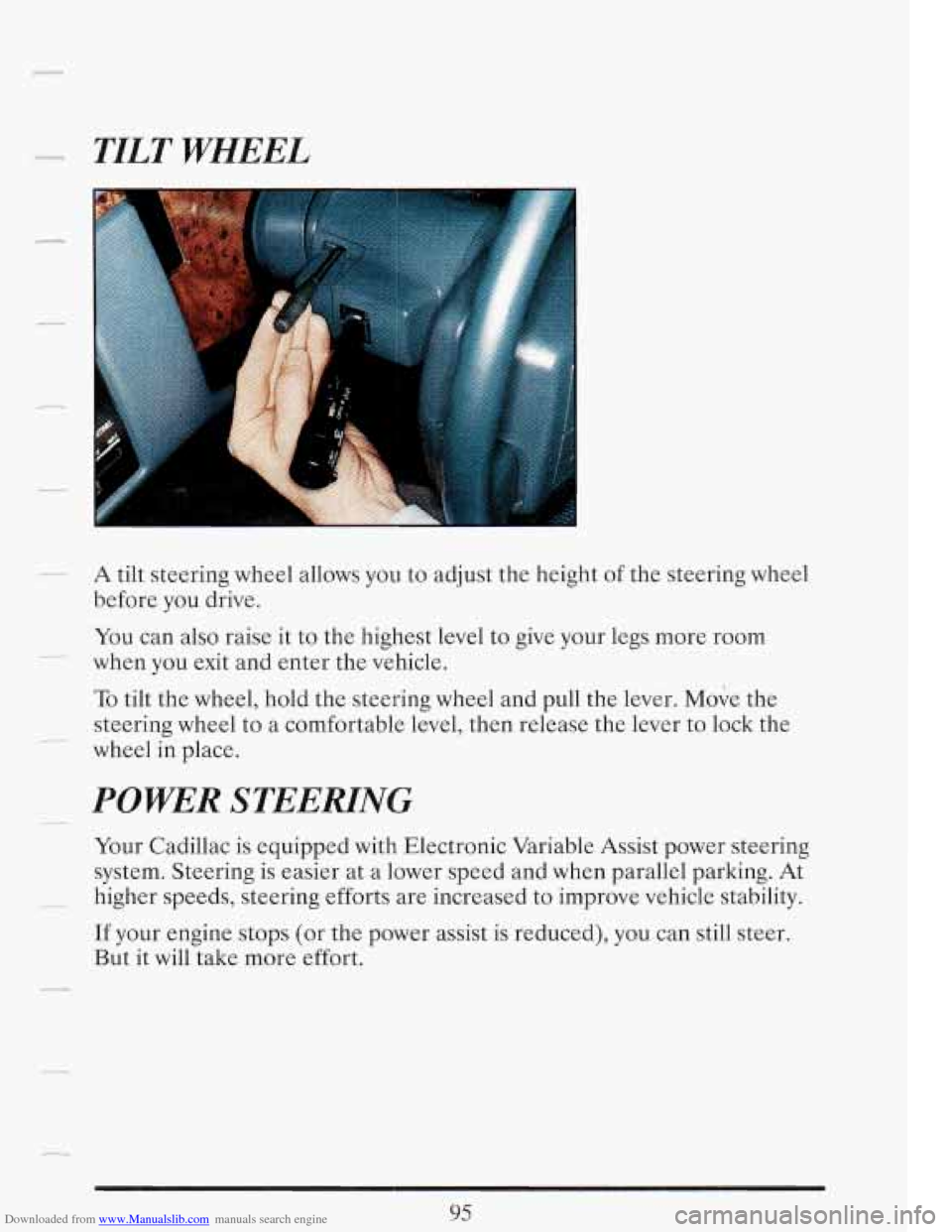
Downloaded from www.Manualslib.com manuals search engine _u_ TILT WHEEL
A tilt steering wheel allows you to adjust the height of the steering wheel
before you drive.
You can also raise it to the highest level to give your legs more room
when you exit and enter the vehicle.
g_
To tilt the wheel, hold the steering wheel and pull the lever. Move the
steering wheel to a comfortable level, then release the lever to lock the
wheel in place.
7
- POWER STEERING
Your Cadillac is equipped with Electronic Variable Assist power steering
system. Steering is easier at a lower speed and
when parallel parking. At
I_ higher speeds, steering efforts are increased to improve vehicle stability.
If your engine stops (or the power assist is reduced), you can still steer.
But it will take more effort.
95
Page 111 of 386

Downloaded from www.Manualslib.com manuals search engine ~ Rear Window Lock Out
HORN
With
this feature you
can cut electrical
power to the rear
power windows
by
pressing the right end
of the lock out switch.
This feature is useful
when you’re transporting small
children and you don’t
want them using the
power windows.
To sound the horn, just press the steering wheel pad.
THE TURN SIGNAEIMULTIFUNCTION
LEVER
97
,
i
Page 193 of 386
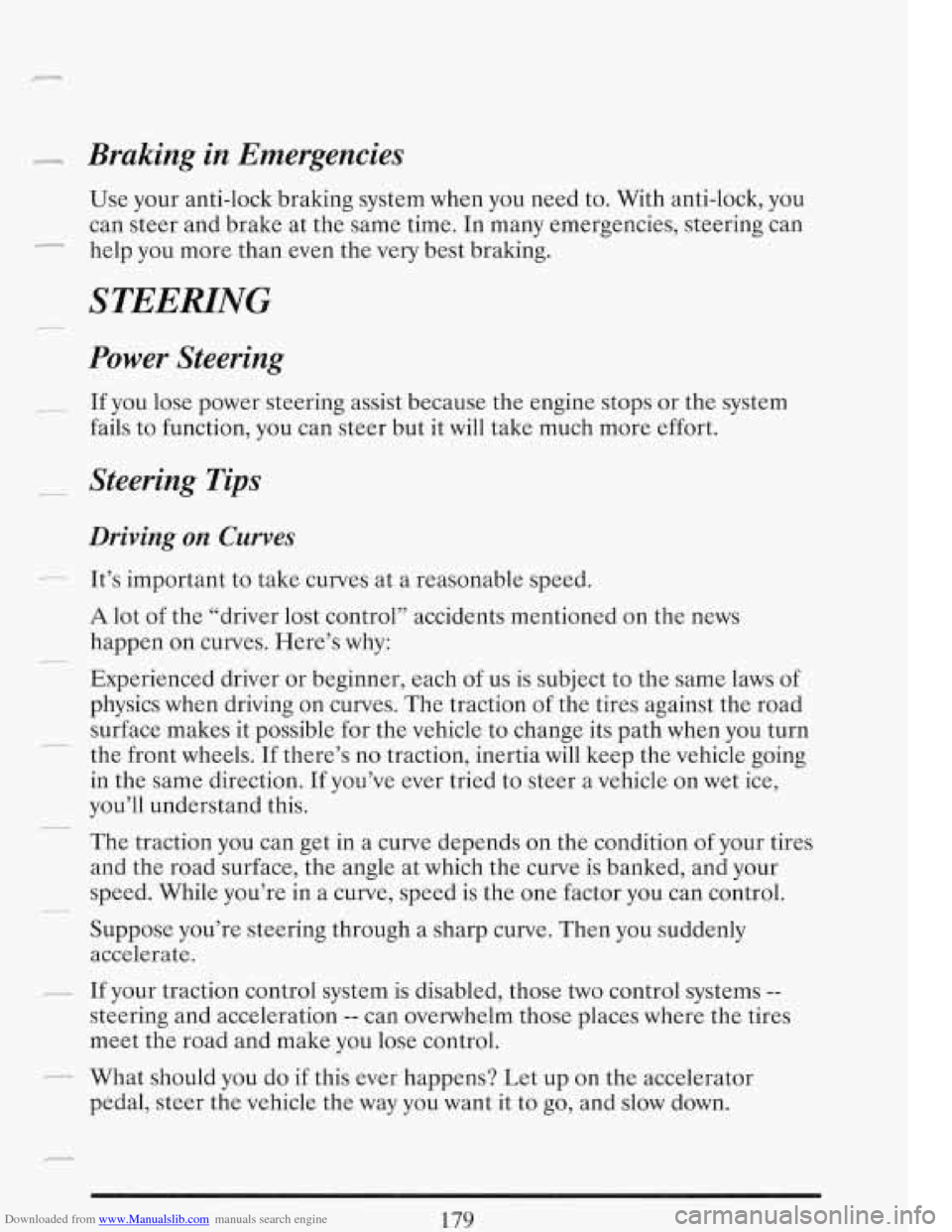
Downloaded from www.Manualslib.com manuals search engine Braking in Emergencies
Use your anti-lock braking system when you need to. With anti-lock, you
can steer and brake at the same time. In many emergencies, steering can
help you more than even the very best braking.
STEERING
Power Steering
If you lose power steering assist because the engine stops or the system
fails to function, you can steer but it will take much more effort.
Steering Tips
Driving on Curves
It’s important to take curves at a reasonable speed.
A lot of the “driver lost control” accidents mentioned on the news
happen on curves. Here’s why:
Experienced driver
or beginner, each of us is subject to the same laws of
physics when driving on curves. The traction
of the tires against the road
surface makes it possible for the vehicle to change its path when you turn
the front wheels. If there’s no traction, inertia
will keep the vehicle going
in the same direction. If you’ve ever tried to steer
a vehicle on wet ice,
you’ll understand this.
The traction you can get in a curve depends on the condition
of your tires
and the road surface, the angle at which the curve is banked, and your
speed. While you’re in a curve, speed is the
one factor you can control.
Suppose you’re steering through a sharp curve. Then you suddenly
accelerate.
If your traction control system
is disabled, those two control systems --
steering and acceleration -- can overwhelm those places where the tires
meet the road and make you lose control.
What should you do if this ever happens? Let up on the accelerator
pedal, steer the vehicle the way you want it to go, and slow down.
179
Page 194 of 386
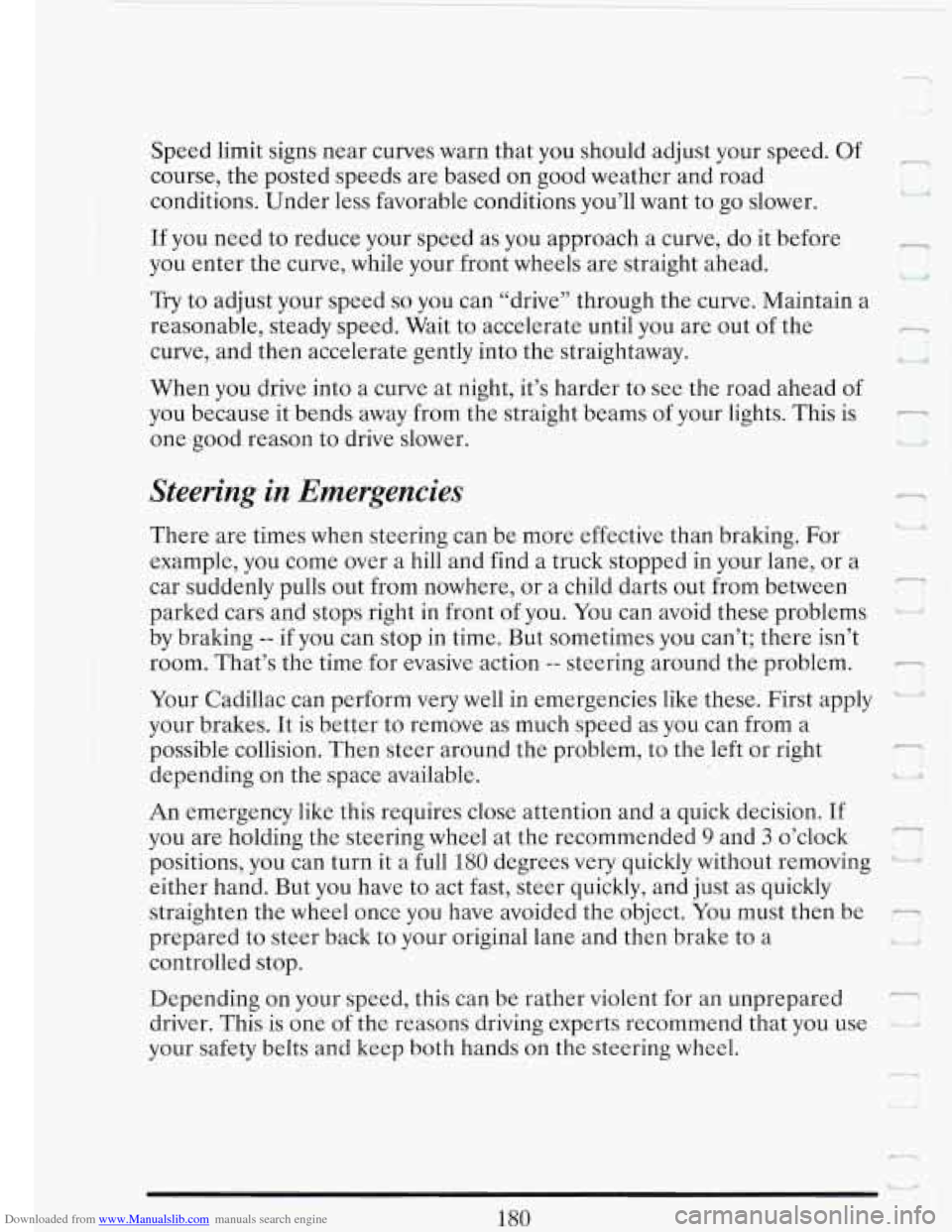
Downloaded from www.Manualslib.com manuals search engine c 1
Speed limit signs near curves warn that you should adjust your speed. Of
course, the posted speeds are based on good weather and road
conditions. Under less favorable conditions you’ll want to go slower.
If you need to reduce your speed as you approach a curve, do it before
you enter the curve, while your front wheels are straight ahead.
Try to adjust your speed so you can “drive” through the curve. Maintain a
reasonable, steady speed. Wait to accelerate until you are out of the
curve, and then accelerate gently into the straightaway.
When you drive into a curve at night, it’s harder to see the road ahead of
you because it bends away from the straight beams of your lights. This is
one good reason to drive slower.
n
cz;
n
Steering in Emergencies
There are times when steering can be more effective than braking. For
example, you come over a hill and find a truck stopped in your lane, or a
car suddenly pulls out from nowhere, or a child darts out from between
parked cars and stops right in front
of you. You can avoid these problems
by braking
-- if you can stop in time. But sometimes you can’t; there isn’t
room. That’s the time for evasive action
-- steering around the problem. -
-
Your Cadillac can perform very well in emergencies like these. First apply
your brakes. It is better to remove as much speed as you can from a
possible collision. Then steer around the problem, to the left or right
depending on the space available. I,
An emergency like this requires close attention and a quick decision. If
you are holding the steering wheel at the recommended
9 and 3 o’clock
positions, you can turn it a full
180 degrees very quickly without removing ‘ i’
either hand. But you have to act fast, steer quickly, and just as quickly
straighten the wheel once you have avoided the object. You must then be
-
7
prepared to steer back to your original lane and then brake to a
controlled stop.
Depending on your speed, this can be rather violent for an unprepared
driver. This is one of the reasons driving experts recommend that you use
your safety belts and keep both hands
on the steering wheel.
-1
r P
180
Page 195 of 386
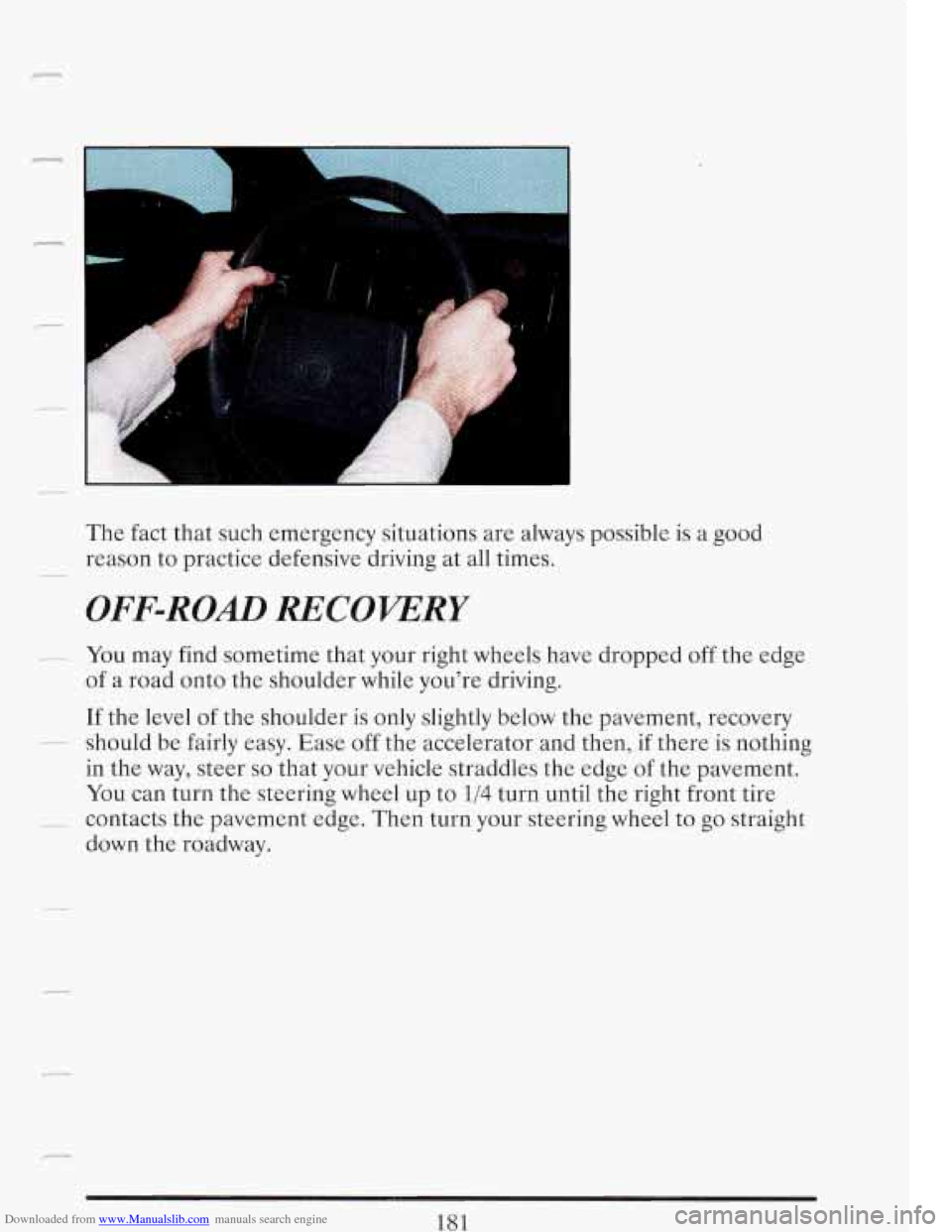
Downloaded from www.Manualslib.com manuals search engine c
7
The fact that such emergency situations are always possible is a good
reason to practice defensive driving at all times.
OFF-ROAD RECOVERY
You may find sometime that your right wheels have dropped off the edge
of a road onto the shoulder while you’re driving.
If the level of the shoulder is only slightly below the pavement, recovery
should be fairly easy. Ease
off the accelerator and then, if there is nothing
in the way, steer
so that your vehicle straddles the edge of the pavement.
You can turn the steering wheel up to
1/4 turn until the right front tire
contacts the pavement edge. Then turn
your steering wheel to go straight
down the roadway.
181
Page 198 of 386
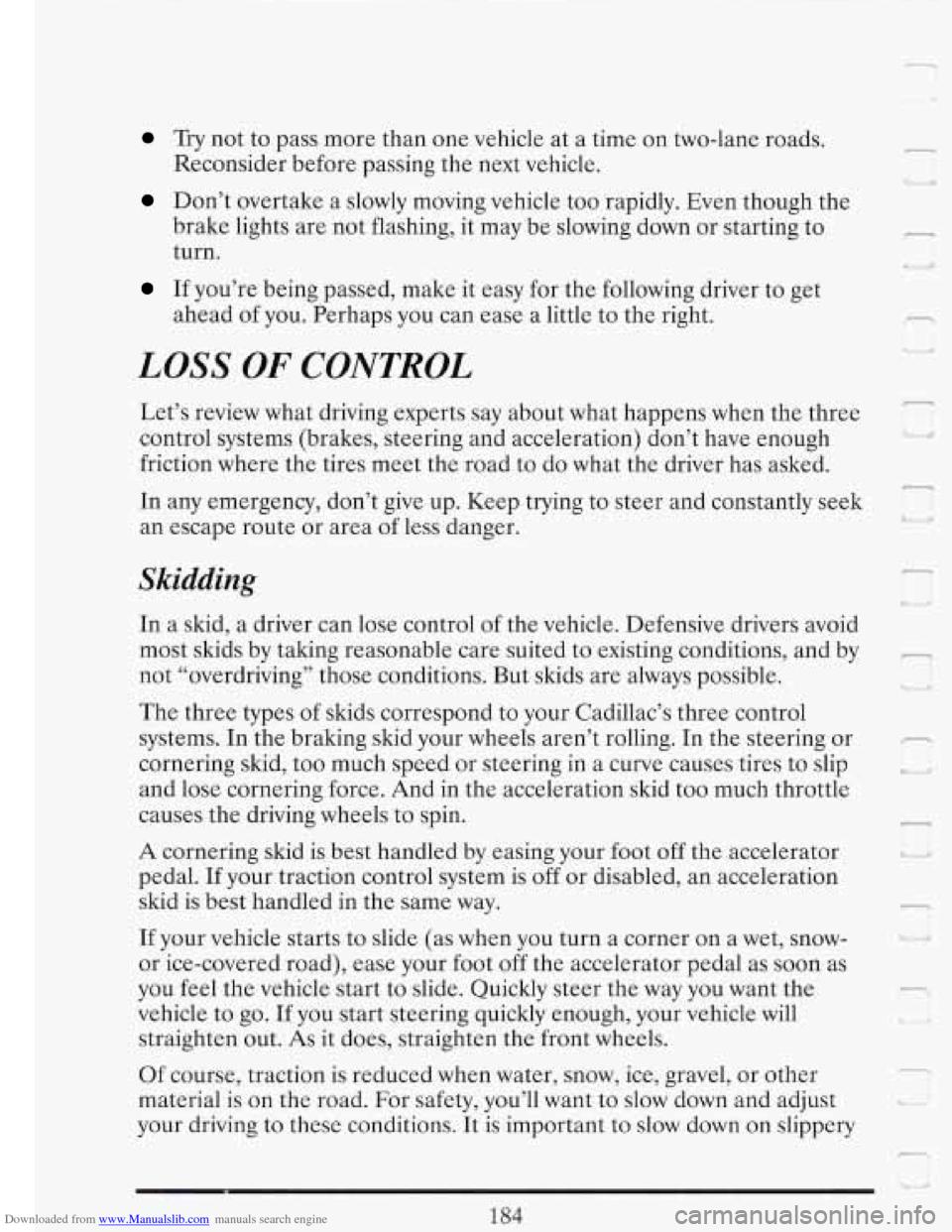
Downloaded from www.Manualslib.com manuals search engine Try not to pass more than one vehicle at a time on two-lane roads.
Reconsider before passing the next vehicle.
Don’t overtake a slowly moving vehicle too rapidly. Even though the
brake lights are
not flashing, it may be slowing down or starting to
turn.
If you’re being passed, make it easy for the following driver to get
ahead
of you. Perhaps you can ease a little to the right.
LOSS OF CONTROL
i
r
I/ U
Let’s review what driving experts say about what happens when the three
control systems (brakes, steering and acceleration) don’t have enough
’; I I
friction where the tires meet the road to do what the driver has asked.
r
In any emergency, don’t give up. Keep trying to steer and constantly seek
an escape route or area
of less danger.
-
le
Skidding
In a skid, a driver can lose control of the vehicle. Defensive drivers avoid
most skids by taking reasonable care suited to existing conditions, and by
._
not “overdriving” those conditions. But skids are always possible. < .,
The three types of skids correspond to your Cadillac’s three control
systems. In the braking skid your wheels aren’t rolling.
In the steering or
cornering skid, too much speed or steering in a curve causes tires to slip
and lose cornering force. And in the acceleration skid too much throttle
causes the driving wheels to spin.
A cornering skid is best handled by easing your foot off the accelerator
pedal.
If your traction control system is off or disabled, an acceleration
skid is best handled in the same way.
If your vehicle starts to slide (as when you turn a corner on a wet, snow-
or ice-covered road), ease your foot off the accelerator pedal as soon as
you feel the vehicle start to slide. Quickly steer the way you want the
vehicle to
go. If you start steering quickly enough, your vehicle will
straighten out.
As it does, straighten the front wheels.
Of course, traction is reduced when water, snow, ice, gravel, or other
material is on the road. For safety, you’ll want to slow down and adjust
your driving to these conditions. It is important to slow down on slippery
Lj
il t
1
-.
184
Page 227 of 386
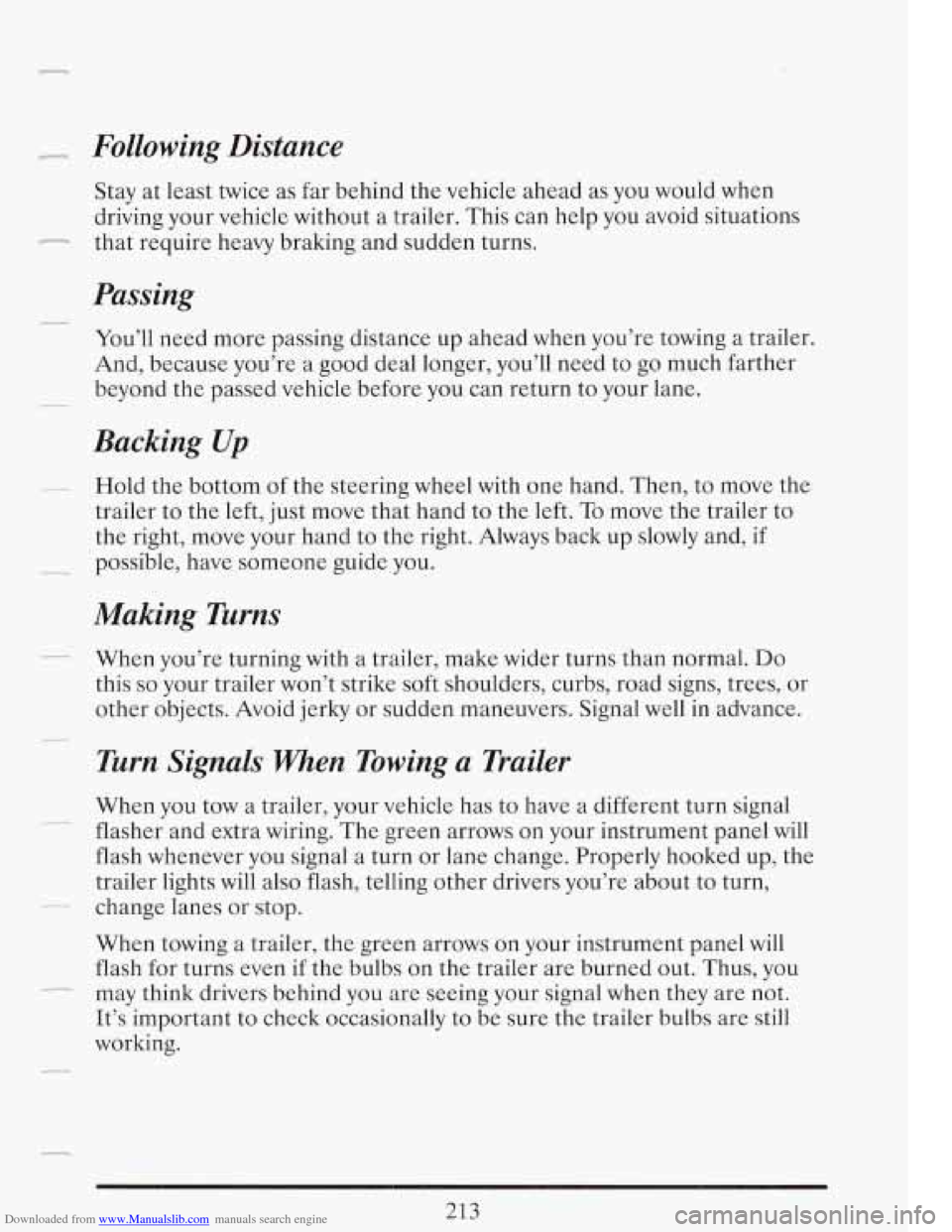
Downloaded from www.Manualslib.com manuals search engine - Following Distance
Stay at least twice as far behind the vehicle ahead as you would when
driving your vehicle without a trailer. This can help you avoid situations
- that require heavy braking and sudden turns.
Passing
I_
You’ll need more passing distance up ahead when you’re towing a trailer.
And, because you’re a good deal longer, you’ll need to go much farther
beyond the passed vehicle before you can return to your lane.
-
Backing Up
_- Hold the bottom of the steering wheel with one hand. Then, to move the
trailer to the left, just move that hand to the left.
To move the trailer to
the right, move your hand
to the right. Always back up slowly and, if
- possible, have someone guide you.
Making Turns
When you’re turning with a trailer, make wider turns than normal. Do
this so your trailer won’t strike soft shoulders, curbs, road signs, trees, or
other objects. Avoid jerky or sudden maneuvers. Signal well in advance.
1urn Signals When Towing a Trailer
When you tow a trailer, your vehicle has to have a different turn signal
flasher and extra wiring. The green arrows on your instrument panel will
flash whenever you signal a turn or lane change. Properly hooked up, the
trailer lights will also flash, telling other drivers you’re about to turn, -
- change lanes or stop.
213
When towing a trailer, the green arrows on your instrument panel will
flash for turns even
if the bulbs on the trailer are burned out. Thus, you
may think drivers behind you are seeing your signal when they are not.
It’s important to check occasionally to be sure the trailer bulbs are still
working. p__-_.
Page 238 of 386
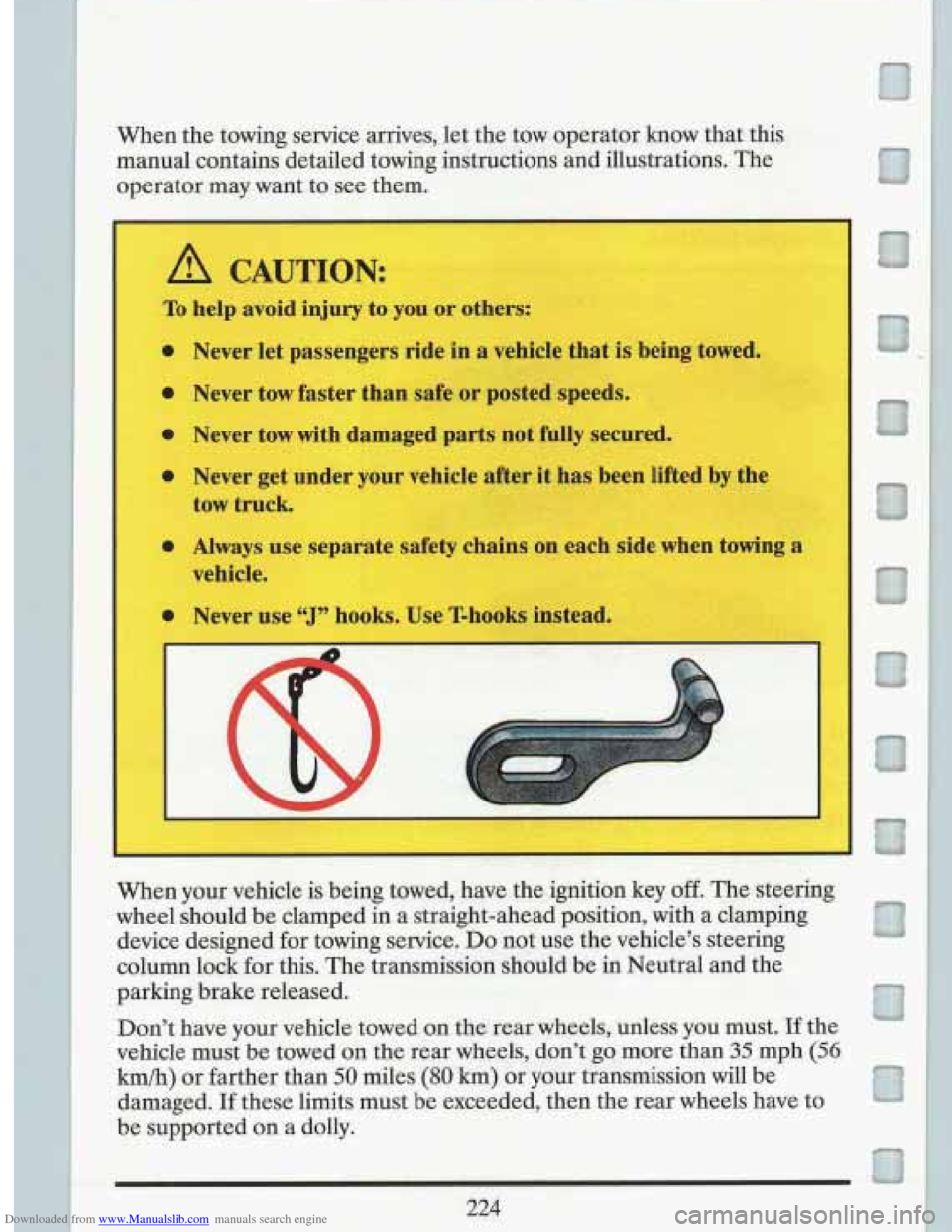
Downloaded from www.Manualslib.com manuals search engine When the towing service arrives, let the tow operator know that this
manual contains detailed towing instructions and illustrations. The
operator may want to
see them.
I
.. .
When your vehicle is being towed, have the ignition key off. The steering
wheel should be clamped in a straight-ahead position, with a clamping
device designed for towing service.
Do not use the vehicle's steering
column lock for this. The transmission should be in Neutral and the
parking brake released.
Don't have your vehicle towed on the rear wheels, unless you must.
If the
vehicle must be towed on the rear wheels, don't go more than
35 mph (56
krn/h) or farther than 50 miles (80 km) or your transmission will be
damaged. If these limits must be exceeded, then the rear wheels have to
be supported on a dolly.
224